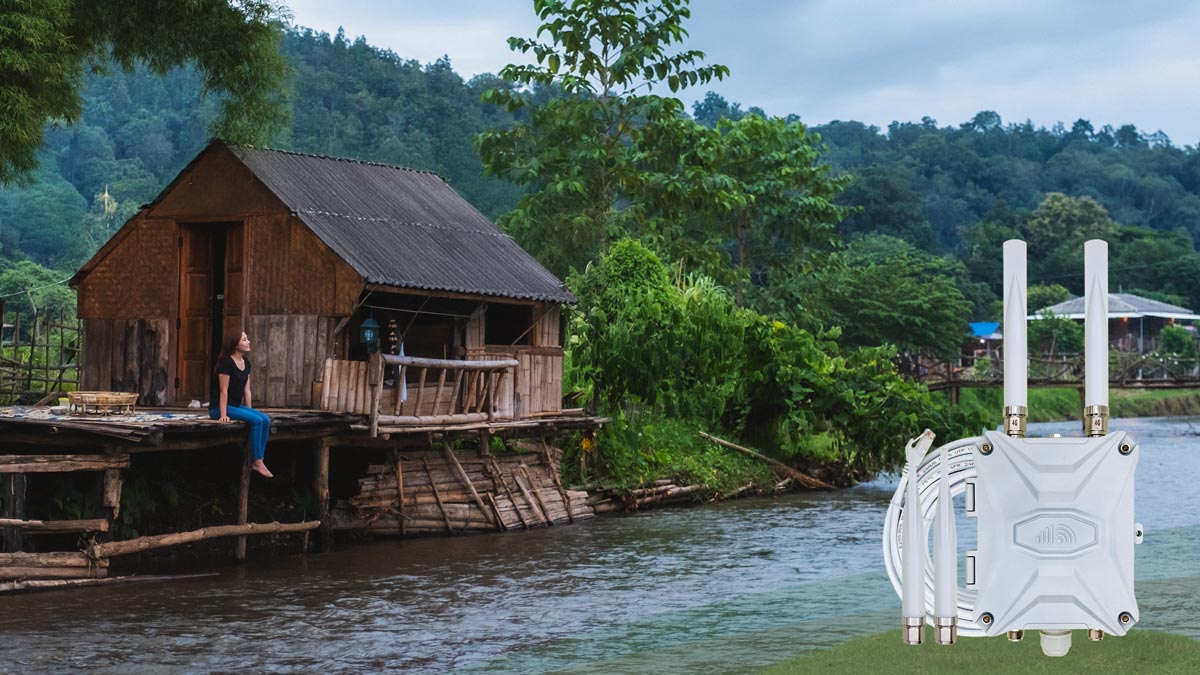SIM Router Solution
Mobile Internet for Rural Cabins Villages Valleys
Living in a valley is a refreshing escape from the hustle and bustle of city life. The rural areas provide breathtaking scenery and tranquility, but they are challenging to acquire stable internet for remote work and keep in touch with friends.
The outdoor SIM card router accessing widely deployed mobile networks and offers a flexible and reliable mobile internet solution. Hereby, we’ll explore why valleys often lack internet, how outdoor SIM routers work, and how to optimize their performance to achieve a strong and stable connection in the most remote areas.
Why Valley Often Lacks Reliable Internet?
Valleys and mountainous areas pose natural barriers to mobile network coverage due to terrain and infrastructure limitations.
Hence, people living in rural valleys suffer from weak mobile signals and unstable wireless internet.
Terrain Obstruction: Hills, slopes, and cliffs block the direct line of sight to nearby cell towers, making it difficult for signals to reach into valley floors.
Weak Signal Penetration: Even with strong 4G/5G coverage at the hilltops, signal strength often fades or drops off totally as it travels downward.
Lack of Wired Infrastructure: Fiber or cable internet is typically unavailable or extremely costly to install in remote areas with low population density.
How Outdoor SIM Router Bring Internet to Valleys
A weatherproof outdoor SIM card router is an excellent choice for setting up a flexible wireless mobile internet gateway and overcoming the harsh conditions in remote areas. It’s designed to work outside in high and exposed locations, like rooftops, tall poles, and hilltops. By positioning the router in these elevated areas, it can capture stronger signals compared to indoor devices.
After inserting a SIM card, the cellular router connects to a 4G or 5G mobile network, just as a mobile phone does. It then shares the internet connection with your devices through Ethernet (wired LAN) or Wi-Fi, enabling multiple users in the mountain valley, whether at home, in an office, or at a remote location, to access the internet at the same time.
Placing the outdoor router in an optimal location helps maintain a stable internet connection, even in the most dense forest valley. Below are the advantages of the waterproof outdoor SIM card router.
Stronger Signal Reception
Mounted high above the ground, outdoor modem routers avoid common obstructions like walls and trees, enabling better signal reception than indoor routers.
Power over Ethernet (PoE)
PoE technology allows sending electric power and acquiring Ethernet data over a single LAN cable. It supports up to 50 meters with minimum attenuation.
Rugged Weatherproof Router
Built for harsh outdoor conditions, IP67-rated waterproof and dustproof and features built-in surge protection – withstand extreme weather.
Failover Internet Gateway
Dual SIM card slots for failover switching the SIM card. Supports multiple WAN and WiFi relay failover, ensuring continuous internet connectivity.
Optimize the Signals and Coverages in Valleys
The mobile signals in remote valleys can fluctuate considerably due to the terrain and various obstructions. Suggest using high-gain and directional antennas to improve the mobile signal quality and maximize router performance. There are two main types of high-gain outdoor antennas commonly used in valley environments.
360° Omni Antennas
Receive signals from all directions – Easy to configure and great for areas where signals reflect off terrain or where the exact tower location is unclear.
Directional Antennas
Best for targeting a visible tower. These antennas focus signal reception in one specific direction, offering improved strength and stability when properly aimed.
If you can see the cell tower or know its exact direction, a directional antenna will give you the best performance. If the tower location is unclear or surrounded by obstacles, an omnidirectional antenna is a better choice.
Extending Outdoor WiFi Coverage
Working outside, the outdoor SIM card router provides natural outdoor WiFi coverage through its WiFi antennas.
The outside WiFi signals don’t travel well through thick walls, metal structures, or over long distances, especially in homes made of stone or concrete in valley areas. To improve indoor WiFi coverage, suggest adding WiFi access points or a secondary router connected via Ethernet to the outdoor router.
Installation Tips for Best Results
To get the most out of your SIM router and antenna setup, consider the following.
Mobile Signal Strength – Utilize a mobile app or signal testing tool to find optimal signal reception locations. Please refer to the field test tutorial to monitor real-time signal metrics and pinpoint the strongest signal area before installation.
Mounting Location – Install as high as possible on rooftops, tall poles, or hilltops. Keep clear of trees, walls, and obstructions. Use PoE to easily bring power and data from your home to the router, even across long distances.
Reduce Interference – Avoid placing your router or antenna near other RF antennas or electronic devices. Keep them at least 3 to 5 meters away to avoid RF interference.
Living in a valley doesn’t mean you have to sacrifice a strong internet connection. With a robust outdoor router, well-placed antennas, and proper installation, you can enjoy a stable and high-speed internet connection. Whether you’re in a mountain cottage, a farm in a valley, or an off-grid retreat, invest in the right SIM router and stay connected!
Don’t hesitate to contact us for expert guidance on selecting the ideal 4G/5G outdoor SIM router for your valley network needs. We’re committed to helping you stay connected, no matter how remote your location may be!

